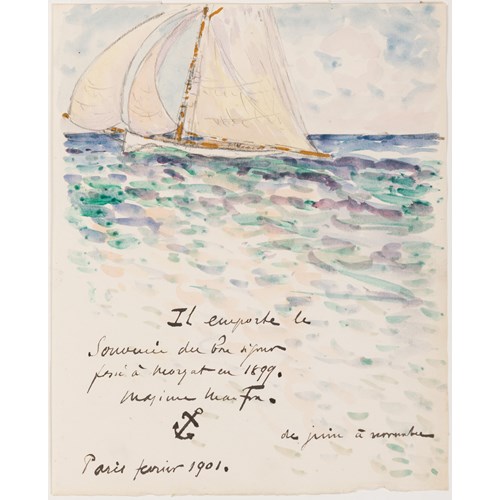Marketplace
View of the ‘Temple of Jupiter Serapis’ at Pozzuoli, after Hubert Robert
Pierre-Adrien PÂRIS
View of the ‘Temple of Jupiter Serapis’ at Pozzuoli, after Hubert Robert
Date 1760
Epoque 1750-1850, 18th century
Origine Naples
Medium Red chalk
Dimension 235 x 311 cm (92¹/₂ x 122¹/₂ inches)
PREVIOUS PRICE: £5,000
SALE PRICE: £4,000
The present sheet is attributed to Pierre-Adrien Pâris, who made several first-rate drawn copies after the Italian landscape drawings of both Robert and Fragonard. The composition of the present sheet is derived from a slightly larger red chalk drawing of the so-called ‘Temple of Jupiter Serapis’ at Pozzuoli by Hubert Robert, today in a private collection. (A variant of the composition by Robert is today in the collection of the Albertina in Vienna.) Robert’s drawing can be dated to 1760, when he and the Abbé de Saint-Non travelled together to Naples to prepare the illustrations for the Voyage pittoresque, ou description historique des royaumes de Naples, et de Sicile. The related engraving in the book is by Charles Guttemberg.
Although the present sheet follows Robert’s drawing fairly closely, there are a handful of significant differences between the two compositions, notably the figures of a man and a woman at the left of centre, which replace the two women found in Robert’s drawing and in other variants of the composition.
Excavated in 1750, the so-called Temple of Jupiter Serapis at Pozzuoli, on the outskirts of Naples, was long thought to have been a temple to the ancient god Serapis, due to the discovery of a statue of the Greco-Egyptian god at the site. It is now known, however, to have been the macellum, or public marketplace, of the town of Pozzuoli. The building was in the form of a square courtyard bordered by an arcade made up of thirty-four columns and decorated with statues. In the centre of the courtyard was a tholos; a circular building standing on a podium, with sixteen columns supporting a domed vault. By the 18th century, however, all that remained at the site was a row of three tall marble columns.
SALE PRICE: £4,000
The present sheet is attributed to Pierre-Adrien Pâris, who made several first-rate drawn copies after the Italian landscape drawings of both Robert and Fragonard. The composition of the present sheet is derived from a slightly larger red chalk drawing of the so-called ‘Temple of Jupiter Serapis’ at Pozzuoli by Hubert Robert, today in a private collection. (A variant of the composition by Robert is today in the collection of the Albertina in Vienna.) Robert’s drawing can be dated to 1760, when he and the Abbé de Saint-Non travelled together to Naples to prepare the illustrations for the Voyage pittoresque, ou description historique des royaumes de Naples, et de Sicile. The related engraving in the book is by Charles Guttemberg.
Although the present sheet follows Robert’s drawing fairly closely, there are a handful of significant differences between the two compositions, notably the figures of a man and a woman at the left of centre, which replace the two women found in Robert’s drawing and in other variants of the composition.
Excavated in 1750, the so-called Temple of Jupiter Serapis at Pozzuoli, on the outskirts of Naples, was long thought to have been a temple to the ancient god Serapis, due to the discovery of a statue of the Greco-Egyptian god at the site. It is now known, however, to have been the macellum, or public marketplace, of the town of Pozzuoli. The building was in the form of a square courtyard bordered by an arcade made up of thirty-four columns and decorated with statues. In the centre of the courtyard was a tholos; a circular building standing on a podium, with sixteen columns supporting a domed vault. By the 18th century, however, all that remained at the site was a row of three tall marble columns.
Date: 1760
Epoque: 1750-1850, 18th century
Origine: Naples
Medium: Red chalk
Dimension: 235 x 311 cm (92¹/₂ x 122¹/₂ inches)
Plus d'œuvres d'art de la Galerie









